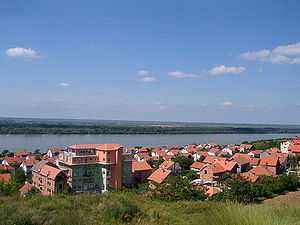Višnjica, Serbia

Višnjica (Serbian Cyrillic: Вишњица, pronounced [ʋîʃɲitsa ]) is an urban neighborhood of Belgrade, the capital of Serbia. It is located in Belgrade's municipality of Palilula.
Location
Višnjica is located on the right bank of the Danube, stretching for almost 5 kilometers, from the Danube's arm of Rukavac and Ada Huja peninsula (including the Višnjica marina) almost to the weekend-settlement of Bela Stena. The original village of Višnjica developed between the northern part of the Višnjica field and the Danube, but today makes one continuous built-up area with the rest of the city, through the bordering neighborhoods of Ada Huja, Rospi Ćuprija and Karaburma on the west and its own modern extension of Višnjička Banja, mainly on the south. The main street connecting it to downtown is Višnjička.
History and population
Until the 1970s, Višnjica was a separate village and a suburban settlement of Belgrade. With the massive administrative reorganization of the Belgrade City limits after the 1971 population census, entire eastern and southern string of more or less urbanized suburbs (Višnjica, Mirijevo, Mali Mokri Lug, Veliki Mokri Lug, Selo Rakovica, Jajinci, Kijevo, Kneževac, Resnik, Železnik, Žarkovo) were administratively annexed to the Belgrade City proper (uža teritorija grada), turning from the separate settlements into the "local communities" (mesna zajednica). Population of Višnjica, according to the official censuses of population:
- 1921 - 1,688
- 1971 - 5,429
- 1981 - 7,463 (as a local community within Belgrade)
- 2002 - 3,611
The 1981 figure covers both Višnjica and Višnjička Banja. The latter split into the separate local community in the 1990s (the combined population of two neighborhoods would be 12,108 in 2002).
The name of the neighborhood, Višnjica, is Serbian for the sour cherry orchard. The entire area, stretching from Karaburma and Viline Vode on the east, was known for its thermal springs and healing mud which gave name to the new neighborhood of Višnjička Banja (Serbian for "Višnjica spa").
Characteristics

As a former village, Višnjica is a residential area without industrial or commercial facilities. The distance from the downtown (7-8 kilometers) and a bad public transportation are the main communal problems in the neighborhood.
Overlooking the easternmost, wooded section of Ada Huja and the Danube itself, Višnjica, just as Viline Vode closer to downtown, was projected as an elite neighborhood in the project of "Belgrade's descend to the river banks". However, the idea of a rich settlement with villas and mansions was dropped with the economic crisis in former Yugoslavia in the late 1980s and succession of Yugoslav wars in 1990s.
Višnjička Banja
Višnjička Banja (Serbian Cyrillic: Вишњичка Бања, pronounced [ʋîʃɲitʃkaː bâɲa]) is located in the northern section of the Višnjica field, between the neighborhoods of Rospi Ćuprija to the west, Lešće to the southeast and Višnjica to the north.
The modern neighborhood was built as an urban connection of the former village of Višnjica to the rest of Belgrade and was so named after many thermal springs and healing mud near Višnjica (Višnjička Banja is Serbian for Višnjica spa). The springs, for the most part, have been artificially shut down and conducted underground into the city's sewage system.
The area is residential, without specific borders with Višnjica itself. Southern section of the neighborhood has many brickworks, but as boundaries of the neighborhoods in Belgrade are mostly arbitrary, some place this industrialized section in Rospi Ćuprija. It had the population of 8,497 according to the 2002 population census.
Višnjičko Polje
Regulatory plan for the construction of the neighborhood of Višnjičko Polje was given green light on May 15, 2007 [1] .[2][3] According to the plan, the future city within the city will cover an area of 81 hectares with 7,500 apartments with a total area of 900.000 square meters. After Bežanijska Kosa in 1987, this is the first grand-scale planned neighborhood of Belgrade.
The neighborhood will be located in the Višnjica field (thus the name). It will border the neighborhoods of Višnjička Banja on the north, Lešće on the east, and Ćalije and Rospi Ćuprija on the west. Future boundary of the neighborhood will also be the projected internal Belgrade's beltway.
As the inclination of the terrain is 7 to 10%, the neighborhood will be built in the amphitheater style. Unlike other planned neighborhoods in Belgrade, Višnjičko Polje will not have sky-scrapers: 50% will make individual houses while only 20% will be made of four-storeys buildings. 600 apartments will be given to the Romani families which currently live in the area in an informal settlement.
The projected neighborhood will have two centers: Center 1, around the present brickworks Rekord, designed for the culture and commerce, and Centar 2, around the present brickworks Kozara, designed for the sports and recreation. The neighborhood will have a nursery, kindergarten, elementary school, sport's fields, etc. Being a massive project, it is expected that 10 to 12 projecting teams will be building it. The city government decided that the neighborhood will be not built partially, but as a whole.
Vrtača, a water hole artificially created as a result of clay digging for the neighboring brickworks, will remain a reservation of nature to protect the present plant and animal life in it. It is currently inhabited by the egrets, mallards. shelducks, grass snakes, etc.
References
- Mala Prosvetina Enciklopedija, Third edition (1986), Vol.I; Prosveta; ISBN 86-07-00001-2
- Jovan Đ. Marković (1990): Enciklopedijski geografski leksikon Jugoslavije; Svjetlost-Sarajevo; ISBN 86-01-02651-6
- Beograd - plan grada; M@gic M@p, 2006; ISBN 86-83501-53-1
- Beograd - plan i vodič; Geokarta, 1999; ISBN 86-459-0006-8
External links
| Wikimedia Commons has media related to Višnjica. |
Coordinates: 44°49′51″N 20°32′52″E / 44.83083°N 20.54778°E